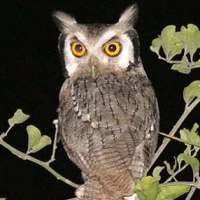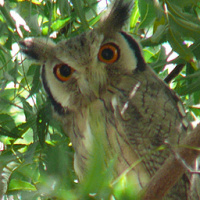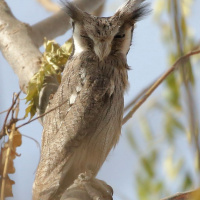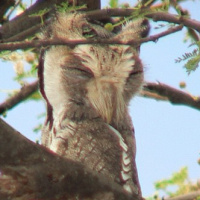Introduction
The Northern White-faced Owl is a small greyish-brown owl with long ear-tufts and a black-rimmed white face. A light and dark morph are known to exist.
Photo Gallery (4 pictures)
Sound Gallery
Information
Description: Light morph: The facial disc is whitish, with a broad blackish rim. The ear-tufts are long, often with blackish
tips. Eyes vary from deep amber-yellow to orange and the bill is yellowish-horn.
Upperparts are pale greyish-brown with many dark shaft-streaks and faint vermiculations. Scapulars have white outer webs, with dark edges. Flight and tail
feathers are barred light and dark greyish-brown. Underparts are paler than the upperparts, with dark shaft-streaks and fine vermiculations. Tarsi are
feathered to the basal half of the toes. Toes are dusky-brown with blackish claws.
Dark morph: Similar, but general coloration is much darker and has an ochre tinge. The facial disc is brownish-white, the crown blackish, and the
ear-tufts have blackish centres.
Size: Length 24-25cm. Wing length 170-209mm. Tail length 75-102mm. Weight 204g average. Females are larger than males.
Habits: The Northern White-faced Owl is a nocturnal bird, roosting by day against a tree trunk, in dense foliage, thorny shrubs and other similar hidden places. At roost the owl is well camouflaged both by coloration and posture; perches upright with feathers held tight to the body appearing very slim, and with the ear-tufts erected and the eyes closed to fine horizontal slits. Paired birds will often roost quite close to one another. Outside breeding season, several individuals may roost at the same site. The owls leave the roost at dusk, and fly to a prominent perch, where they often start singing. Calling may be heard at any time of the night, but most frequently at dusk or just before dawn.
Voice: The song of the male is a disyllabic, mellow fluting po-prooh, repeated several times at intervals of 4-8 seconds. The female's song is similar, but weaker and higher in pitch. A low to-whit-to-wheet given by both sexes is likely a contact call. When threatened, this owl emits squeaky growls.
Hunting & Food: The Northern White-faced Owl feeds on invertebrates such as moths, crickets, beetles, scorpions, and spiders, as well as small vertebrates such as reptiles, birds and mammals (especially rodents and shrews). Hunting is done from a perch, with the owl swooping down on its prey on the ground. Prey is generally swallowed whole. Pellets are usually regurgitated at the roost, and accumulate on the ground below if the site is used for some time.
Breeding: At the start of the breeding season, the male is very vocal, singing from different perches in its territory or at potential
nesting sites. Male and female often duet during courtship. The male approaches the female and bobs his head up and down while singing, and the female
answers with song or a chirruping call. Potential nest sites are advertised by the male. These may be natural holes or hollows and crevices in old trees,
or old stick nests of larger birds in bushes or trees. The chosen site is normally 2-8 metres above the ground, and may be used for several years by the
same pair.
Egg laying has been recorded from January to September. There is normally one clutch per year. Usually 2-3 (sometimes 1-4) white shiny eggs are laid,
measuring 36.6-37.3 x 30.3-31.3mm, at intervals of about two days. Incubation starts with the first egg, and is done by the female alone while the male
provides the food. The female turns the eggs frequently during the incubation period, which is about 30 days.
The chicks are brooded and fed by the female with prey brought in by the male. At seven days, they are able to sit up, and at 27 days the young appear
fully feathered and may leave the nest to climb around nearby branches. By 30-32 days they are able to fly well. They are cared for and fed by both
parents for at least 2 weeks after leaving the nest.
Habitat: The most preferred habitats are dry savannas with thorn trees and not too dense riverine forests and woods along watercourses. Also found in savanna with scattered trees, dry open forest, woodland with closed canopy, forest edges and clearings. Absent from deserts and dense tropical rainforest.
Distribution: Africa south of the Sahara, from Senegambia eastwards to Sudan, Somalia, north Uganda and north Kenya. Probably overlaps the distribution of the similar Southern White-faced Owl in Kenya and Uganda.
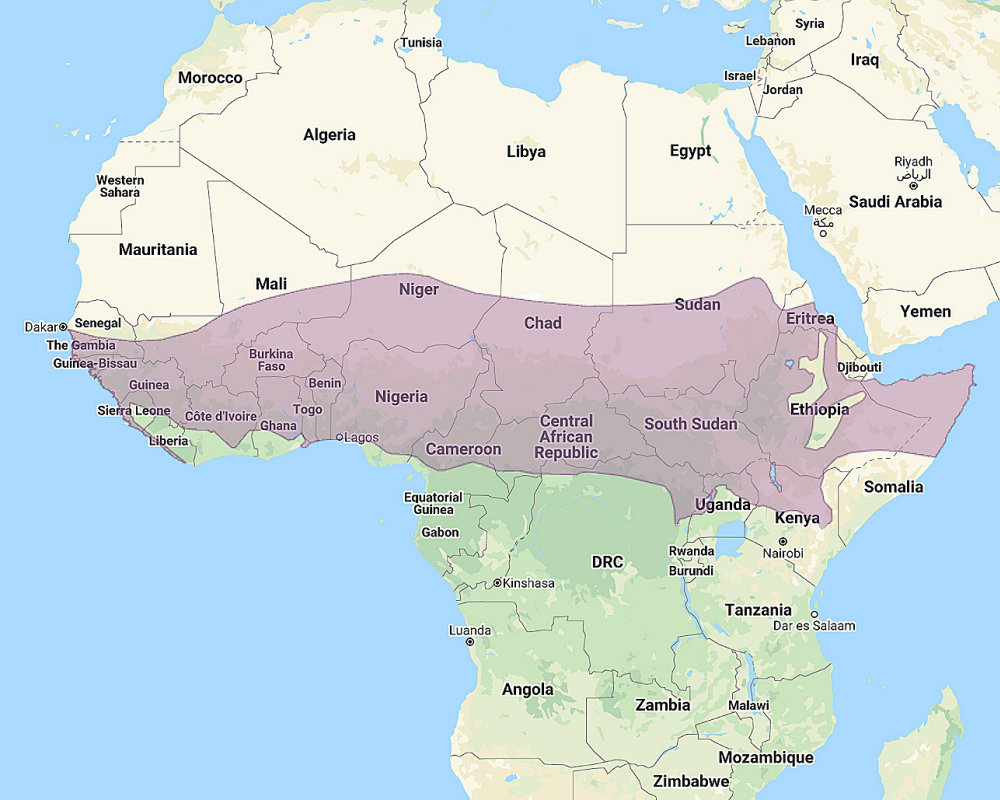
Range of the Northern White-faced Owl Ptilopsis leucotis
Status: Uncommon to locally common and widespread in suitable habitats; abundance varies locally.
Original Description: Temminck, Coenraad Jacob. 1820. Novueau recueil de planches coloriees d'oiseaux, pour servier de suite et de complement aux planches enuminees de Buffon: livraison 3, pl 16.

